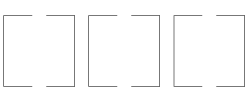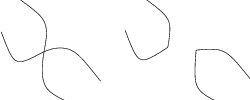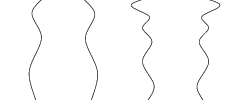Perceptual organization
Perceptual grouping refers to the human visual ability to extract significant image relations from lower-level primitive image features without any knowledge of the image content and group them to obtain meaningful higher-level structure.
Research in perceptual grouping was started in 1920's by Gestalt psychologists, whose goal was to discover the underlying principle that would unify the various grouping phenomena of human perception. Gestalt psychologists observed the tendency of the human visual system to perceive configurational wholes, with rules that govern the uniformity of psychological grouping for perception and recognition, as opposed to recognition by analysis of discrete primitive image features. The hierarchical grouping principles proposed by Gestalt psychologists embodied such concepts as grouping by proximity, similarity, continuation, closure, and symmetry.

Proximity |

Similarity |

Continuation |

Closure |

Symmetry |
|
The members of the Gestalt school described what is computed in perceptual grouping, but didn't find out why or how these computations were made. In the 1990's, Sarkar and Boyer proposed a classificatory structure of perceptual grouping in Computer Vision divided in four levels: the signal level organises individual pixels or interest points into extended regions, edge chains or groups of points; the primitive level organises the features detected in the signal level into contours or region limits; the structural level searches for 2D structures like loops, corners, polygons or closed regions; The 2D structures generated at the structure level are further organised in the assembly level in order to identify relations among them.
Our experience in perceptual organisation consists in the design and implementation of a fully automatic framework for the detection of structured objects in 2D images. The framework starts at the signal level, where a Gabor decomposition extracts the directional primitives present in an image and a pyramid of artificial neural networks organises and integrates the results into a unique output. Next, in the primitive level, a line segment detector based on the principles of the fuzzy Hough transform and the Burns segment detector, is developed to group the edge pixels into straight line segments. The framework ends at the structural level, that integrates the relationships offered by Gestalt psychology (parallelism, continuity, closure, etc.) among line segments in order to form large groups.

Main publications
-
,
,
,
,
,
,
,
,
,
"Automated classification of protein crystallization images using support vector machines with scale-invariant texture and Gabor features",
Acta Crystallographica Section D,
D62,
271-279,
2006.
[PDF] -
,
,
,
,
"Efficient combination of the fuzzy Hough transform and the Burns segment detector",
Lecture Notes in Computer Science (selected papers EUROCAST'07),
4739,
733-739,
2007.
[Abstract] [PDF] [+Info.]
-
,
,
,
,
,
"Certainty Measure of Pairwise Line Segment Perceptual Relations using Fuzzy Logic",
LNCS, Progress in Pattern Recognition, Image Analysis and Applications,
4756,
477-486,
2007.
[Abstract] [PDF] [+Info.]
-
,
,
,
"A neural network based framework for directional primitive extraction",
Neural Processing Letters,
27 (1),
67-83,
2008.
[Abstract] [PDF] [+Info.]
-
,
,
,
,
"Comparison of Alternative Frameworks for Directional Primitive Estraction",
Pattern Recognition and Image Analysis,
17, Nº 4,
439-449,
2007.
[Abstract] [PDF] [+Info.]